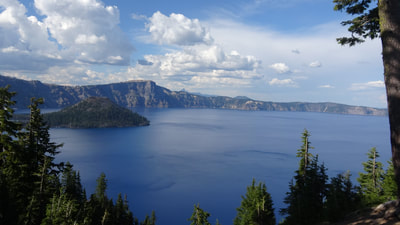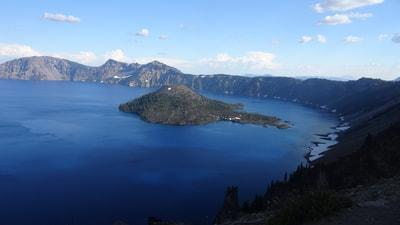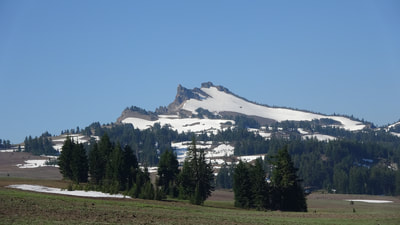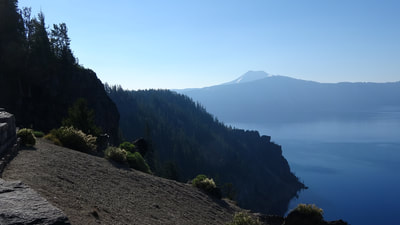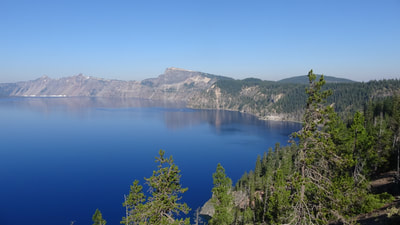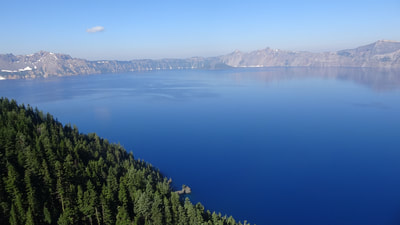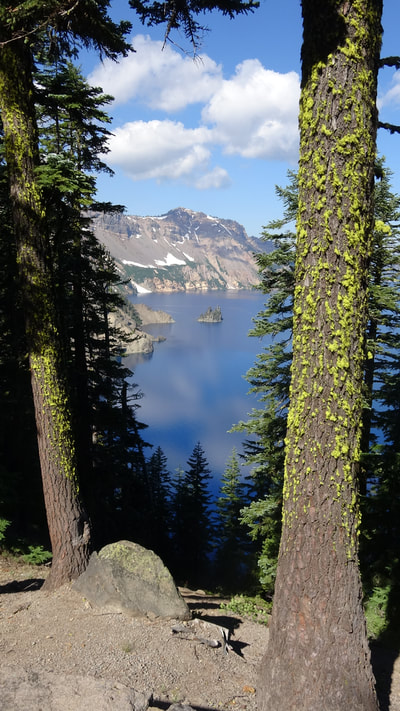The Deepest Blue and the Deepest Lake in the U.S.
|
By JOE CARTWRIGHT
Special to North Palm Beach Life Located in the Southern Cascade mountain range in Oregon is a park with the deepest lake in the United States. Crater Lake is almost 2,000 feet deep, and the park gave us an interesting time in the two full days we spent there. Crater Lake National Park has its central attraction – the lake itself – in the center of the park. The round lake is about 6 miles long by about 5 miles wide, with a surface area of about 20 square miles. A loop road circles the lake and presents the visitor with beautiful views of the lake or the surrounding countryside. The raw beauty of this lake is this park’s primary drawing. |
All Photos: Joe Cartwright
Somewhere around 5700 BC, tribes of Native Americans in what is now Oregon and northern California witnessed a volcanic eruption of staggering magnitude. Those who saw the eruption of Mount Mazama and survived the experience could not have known that they were witness to the formation of the massive pit that would create Crater Lake. Today, the rim around Crater Lake is what remains of Mount Mazama. Geologists estimate that Mount Mazama lost more than a mile of height in the eruption. Debris from the eruption has been found as far away as Montana and Nevada.
|
|
Fortunately, archeological evidence indicates that the immediate Mount Mazama area was never the permanent home for any groups of people. The Klamath Indians are descendants of the Makalak people; the Makalaks were a group living in an area southeast of what is now Crater Lake National Park. Accounts of the eruption live on in the traditional stories told by the Klamath Indians today. From the earliest days of the lake, it has been regarded as sacred site by the Klamath Tribe. Since they regarded the site as sacred, the Klamath Tribe was not eager to share the location with the incoming white settlers. The first non-natives to see – and talk about – the lake were a group of miners led by John Wesley Hillman. They stumbled on the lake while searching for a “lost gold mine” in 1853. Although they were impressed by the beauty of the lake, the best name they could think up was “Deep Blue Lake." After some name changes – “Blue Lake”, “Lake Majesty” – a newspaper editor suggested “Crater Lake” in 1869. Evidently, that was the name that stuck. The lake and the area around it were finally set aside as a National Park in 1902. The pit formed by the eruption stays filled with water from rain and snowmelt; no creeks or rivers flow into it, or out of it. This has made Crater Lake’s water unusually clear and pure. Features on the bottom of the lake are visible at depths of 80 to 100 feet, or more. The water is so pure, and so cold, that one large log has floated in it for over a century. The hemlock log is called The Old Man of the Lake, and has been bobbing vertically in the lake since before 1896. No fish are native to Crater Lake, but a stocking program introduced several species of fish to the lake between 1888 and 1941. Today, only Rainbow Trout and Kokanee Salmon remain. Since these species are not native to the lake, fishing is not only allowed, but encouraged along the lake shores. Only artificial lures are allowed, because no other invasive species (ex: minnows, worms) should be introduced into the lake. |
|
Crater Lake has two islands: Wizard Island is a 315-acre cone-shaped island near the western shore of the lake. The Phantom Ship is a very small, rugged island, 500 feet by 200 feet, in the southern part of the lake. A concessionaire runs a boat service between a dock on the lake shore and Wizard Island.
The Crater Lake area receives a truly awesome amount of snowfall each winter; it averages almost 500 inches of snow each year. When we arrived for our visit late in July, large snowbanks were still scattered throughout the area. Even this late in the summer, one of the park’s most popular trails, the Watchman Peak Trail, was still buried under feet of snow. Seeing the lake begins with a trip around the Rim Drive. This loop road is about 33 miles around, and is dotted with pullouts and lake views. On the northern part of the loop is the only lake access trail available. The Cleetwood Cove Trail leads from Rim Drive, over the rim, and down to the lake shore near a set of boat docks. In most places around the lake, the shore line is much too steep to allow access to the lake. |
|
On the eastern side of the Rim Drive, a spur road leads to a bizarre area of the park, known as The Pinnacles. After gazing at the calm beauty of the lake, the pinnacles is a complete turnaround: Thin, tall spires in a desolate, vegetation-starved valley. From the end of the Pinnacles Road, a trail continues on along the rim to further explore this unique area. Also on the Pinnacles Road is the trail head to Plaikni Falls. Lost Creek Campground is a small campground located on the Pinnacles Road.
One road leads north from Rim Drive, toward the north entrance of the park. This road passes through another feature of the park, the Pumice Desert. This area is covered with volcanic pumice rocks and soil; the pumice soil drains very rapidly, retaining little or no moisture. As a result, vegetation is very sparse in this area. Compared to the dense, lush growth of plants in other areas of the park, the area does seem very much like a desert. The north entrance road connects with Oregon Route 138, leading through the small community of Diamond Lake. Fuel, food, lodging, and camping are available at Diamond Lake. Crater Lake National Park has several interesting trails. Besides the ones already mentioned, the Pacific Crest Trail (featured in the Reese Witherspoon movie, Wild) travels through the western side of the park. Several short trails show the park’s features up close. The Sun Notch Trail gives great views of the Phantom Ship island, and the lake. The Castle Crest trail is a short nature trail that leads through a wildflower-filled meadow. The Godfrey Glen trail is a one mile loop that takes you through forests and alongside a canyon. Most of the Crater Lake trails are about two miles or less, but those that lead to the summits of area mountains can be up to ten miles long. All services in the park are located in the southern section. Rim Village has lodging at Crater Lake Lodge; a cafe, gift shop, and a visitor center are also located there. Further south, and away from the lake, Mazama Village has cabins, a cafe, a gift shop and a campground. No gas stations are located within the boundaries of the park. Gas and diesel are available at Diamond Lake, just north of the park boundary, and at some of the communities south of the park. Winter closes most of the roads in Crater Lake National Park to auto traffic. Roads from the south, up to Rim Village are kept open year round. Most services in the park are not open in the winter. Crater Lake National Park proved to be a delightful destination: A gorgeous, hyper-photogenic mountain lake with enough side attractions to give each visitor a diverse experience. |








